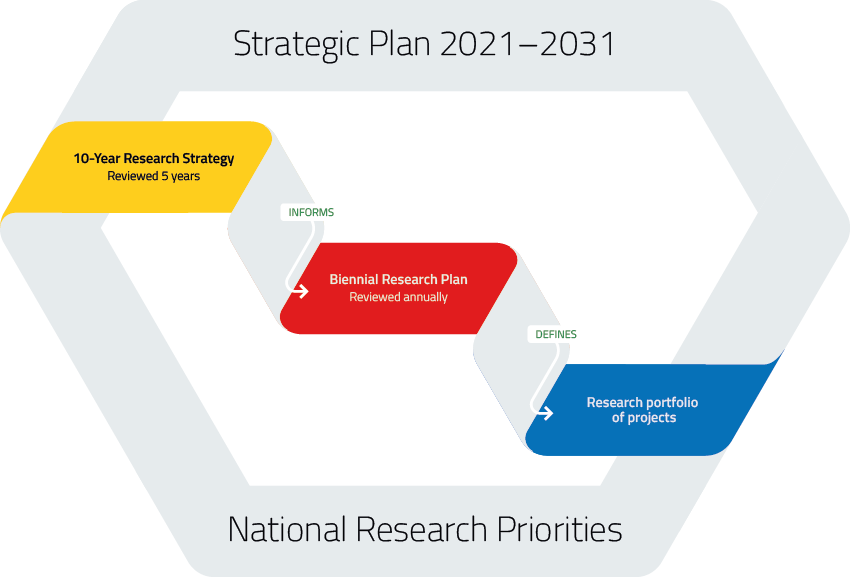
When Natural Hazards Research Australia (the Centre) began operations in July last year, we had already started building the foundations for a new research portfolio. This was a rare opportunity to collaboratively develop a program of research that would deliver on our guiding vision: that communities will be safer, more resilient and sustainable in the face of natural hazards.
Setting the Centre up to achieve this vision is complex and multi-faceted, so I wanted to explain what we have been doing so far and how this will continue past this year of establishment.
Below are the key stages we identified for a successful research development process, starting with big-picture strategy and influences and narrowing toward a specific portfolio of projects. Given the limited timeframe and the urgency to get some vital research up and running, these stages are substantially happening in parallel with each other rather than chronologically.
The Centre’s corporate direction
The Centre’s Board has developed the overarching corporate vision and strategy of the Centre. You can read the Strategic Plan 2021—2031. It’s a big-picture document that outlines our vision, mission, partners, principles, plans and strategic themes.
The Board has identified seven key result areas for the Centre to focus on:
- undertake leading research
- create and assist knowledge networks
- create national research data frameworks
- build partnerships
- create a national research capability
- provide a trusted and independent voice
- translate research into action.
Australia’s natural hazard research priorities
While the strategic direction was being developed, we also needed to assess the nation’s natural hazards research priorities – building on what we already knew about disaster risk reduction and identifying any knowledge gaps. We used eight overarching research themes as a guide for a series of collaborative workshops last year. We worked with key partners from government, emergency management agencies, private sector organisations and not-for-profit companies to develop a list of possible research priorities within each theme. You can read more about this process and the priorities here.
The soon-to-be-released National Research Priorities paper is intended to provide research guidance to the whole sector. There is no expectation that the Centre will be able to address all of the national priorities on its own.
Our own research agenda
We are also working on the Centre’s 10-Year Research Strategy that will detail the themes and factors influencing our research focus. Practically speaking, this document will inform our decisions about which kinds of research projects we should fund in the short-, medium- and long-term. As a strategic document, it highlights what we will be trying to achieve over 10 years rather than what specific research we will be doing – this will be defined in the rolling Biennial Research Plans mentioned below.
The 10-Year Research Strategy will be reviewed every five years and will be heavily influenced by the National Research Priorities, the National Disaster Risk Reduction Framework, the findings and recommendations of the Royal Commission into National Natural Disaster Arrangements (and similar inquiries) and the evolving threats of natural hazards in a changing climate.
Developing the 10-Year Research Strategy is highly collaborative and being done in close consultation with our partners – drawing on the workshops mentioned above while linking back to our vision, with a heavy emphasis on usability of research. The strategy outlines a need for balance across mitigation, response and recovery, across different types of hazards and projects of different lengths and types.
Specific research planning
Our research plans and projects will be outlined in a rolling Biennial Research Plan. This is where you will find a specific list of the research funding areas for the coming 12 month-period.
These plans will be reviewed annually to make sure we are responding to new knowledge needs, based on unfolding natural hazards, impacts of our changing climate, and other changes that affect our risks, vulnerability or resilience to natural hazards.
Our first Biennial Research Plan will cover the research for the second half of 2022 through to 2024 and will be distributed by the end of June 2022 after approval by our Board.
In the meantime, we have identified the Centre’s more immediate research focus areas here, which enable us to address short-term research needs while we develop our first Biennial Research Plan.
These immediate focus areas, which are already funding much-needed research projects, are being guided by:
- advice provided by our partners and topics arising from the national research priorities workshops
- evolving natural hazards risks, exposures and vulnerabilities
- the National Research Priorities
- our agreement with the Australian Government during our establishment.
A rolling portfolio of projects
In terms of specific research projects we have funded so far, we have focused on research addressing the ongoing and immediate needs of our partners and Australian communities as they continue to be battered by damaging natural hazards.
For example, we have continued to fund research addressing the knowledge gaps revealed during the bushfires of 2019—20. We have recently approved funding for research projects looking at flash flooding and how to better keep communities safe from floodwater. We are also funding First Nations-led research that can strengthen collaboration and learnings from First Nations’ land management – a major recommendation from the Royal Commission.
Every year throughout our 10-year funding period, we will be regularly adding new research projects to our portfolio, including core research, projects commissioned by partners, graduate projects and quick response research. There will be two main investment rounds each year, to ensure we can be responsive to the needs of our partners and the community as disasters occur.
All of our research projects, including those with calls for Expressions of Interest (of which there are many more to come), can be viewed on our website.
I hope this has helped explain the way we have developed our research portfolio during the establishment of our new Centre, but if you have any questions or want to chat about it, please get in touch with me at john.bates@naturalhazards.com.au.

